How to Install EteSync 2.0 (Etebase) Server on Ubuntu
This tutorial is going to show you how to install EteSync server on Ubuntu. EteSync is an open-source, end-to-end encryption solution for syncing your calendars, contacts, tasks and notes.
EteSync Features
The latest version is EteSync 2.0, which features
- End-to-end encryption.
- No separate encryption password needed. You just need one password that’s used for both the encryption, and the login.
- Zero-knowledge proof to authenticate to the server making sure your password never leaves your device.
- Instant synchronization between your devices.
- The ability to share data with other users
- Clients are available for the desktop (DAV bridge), the web, Android, and iOS.
- Integration with GNOME and KDE desktops (EteSync backend for Evolution and Akonadi).
- An add-on for Mozilla Thunderbird.
- Upgrade to the new Etebase protocol.
In the near future, EteSync will also add support for secure location sharing. EteSync provides hosted service at etesync.com. I will show you how to run a self-hosted instance on Ubuntu server and how to use the client software on various platforms.

Step 1: Install the Latest Stable Version of MariaDB Server on Ubuntu
By default, EteSync stores user information in SQLite database. If you prefer to use MariaDB, follow the instructions below.
You should use the latest stable version of MariaDB, which is 10.5, because there will be problems if you run EteSync with MariaDB 10.3. To install the latest stable version, run the following commands to add the MariaDB repository on Ubuntu 20.04.
sudo apt-get install software-properties-common sudo apt-key adv --recv-keys --keyserver hkp://keyserver.ubuntu.com:80 0xF1656F24C74CD1D8 sudo add-apt-repository 'deb [arch=amd64,arm64,ppc64el] http://mirror.lstn.net/mariadb/repo/10.5/ubuntu focal main'
To add the repository on Ubuntu 18.04, simply replace focal with bionic in the third command.
Then update package index and install MariaDB server.
sudo apt update sudo apt install mariadb-server
If you are upgrading an existing MariaDB server to the latest version, you might see the following message. I recommend choosing N to keep the current version and examine what needs to change later.

If there’s a package dependency problem, you can run the following command to fix it.
sudo apt --fix-broken install
Once the installation finishes, MariaDB server automatically starts. You can check its status with:
systemctl status mariadb
As you can see, it’s active and running.
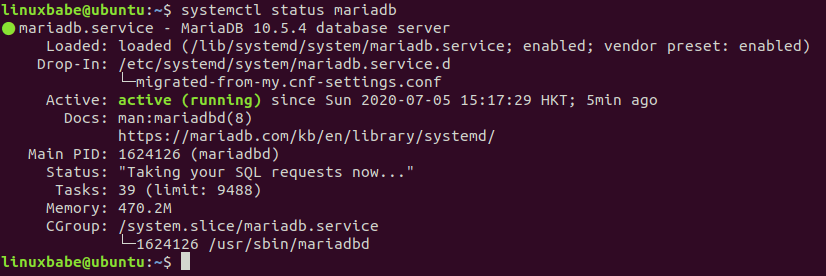
Hint: Press Q to gain back control of the terminal if the above command doesn’t quit immediately.
If it’s not running, you can manually start it with:
sudo systemctl start mariadb
To enable auto-start at boot time, run
sudo systemctl enable mariadb
Step 2: Create a Database and User for EteSync in MariaDB Database Server
Log into MariaDB database server with the following command. Since MariaDB is now using unix_socket plugin to authenticate user login, there’s no need to enter MariaDB root password. We just need to prefix the mysql command with sudo.
sudo mysql
Then create a database for EteSync. This tutorial names the database etebase. You can use whatever name you like.
create database etebase;
Create the database user. Again, you can use your preferred name for this user. Replace your-password with your preferred password.
create user etebase@localhost identified by 'your-password';
Grant this user all privileges on the etebase database.
grant all privileges on etebase.* to etebase@localhost;
Flush privileges and exit.
flush privileges; exit;

Step 3: Install EteSync 2.0 Server on Ubuntu
Install Python3 virtual environment creator and some package-building tools.
sudo apt install python3-virtualenv python3-pip gcc build-essential
Go to your home directory.
cd
Clone the EteSync repository from Github.
git clone https://github.com/etesync/server.git etebase
Change to the newly-created directory.
cd etebase
Create a Python3 virtual environment.
virtualenv -p python3 .venv source .venv/bin/activate pip install -r requirements.txt
Copy the example configuration file.
cp etebase-server.ini.example etebase-server.ini
Edit the file.
nano etebase-server.ini
Find the following line
;media_root = /path/to/media
Uncomment it and change the value.
media_root = /home/username/etebase/media/
Find the following line,
allowed_host1 = example.com
Use a sub-domain like etebase.example.com.
allowed_host1 = etebase.example.com
By default, EteSync stores user information in SQLite database. If you prefer to use MariaDB database server, then comment out the following two lines (Add a semicolon at the beginning of each line).
engine = django.db.backends.sqlite3 name = db.sqlite3
Then add the following lines at the end of this file. This tells EteSync how to access the etebase database in MariaDB, which is created in step 1. Obviously you need to use your own password for the etebase user.
engine = django.db.backends.mysql
name = etebase
user = etebase
password = your-password
host = 127.0.0.1
port = 3306
Save and close the file. Etebase server is a Django application, we can use Daphne (the Django Channels HTTP/WebSocket server) to run Etebase. Install Daphne with:
pip3 install daphne
Since we use MySQL/MariaDB as the database engine, we also need to install the mysqlclient module.
sudo apt install libmysqlclient-dev pip3 install mysqlclient
Install the aioredis module in order to use Redis cache.
pip3 install aioredis
Create Django’s static files.
./manage.py collectstatic
Initialize the app.
./manage.py migrate
Start EteSync 2.0 (Etebase) server.
daphne -b 0.0.0.0 -p 8001 etebase_server.asgi:application

Step 4: Run EteSync as a Systemd Service
We can manually start EteSync with daphne -b 0.0.0.0 -p 8001 etebase_server.asgi:application, but it’s more convenient to run EteSync as a systemd service in the background. Press Ctrl+C to stop the current EteSync instance.
Create a systemd service unit file for EteSync with the following command.
sudo nano /etc/systemd/system/etebase.service
Put the following lines into the file. Replace username with your real username.
[Unit] Description=EteSync: End-to-End Encryption to Sync Calender, Contacts, Tasks and Notes. [Service] WorkingDirectory=/home/username/etebase/ ExecStart=/home/username/etebase/.venv/bin/daphne -b 127.0.0.1 -p 8001 -u /tmp/etebase_server.sock etebase_server.asgi:application User=username Group=username Restart=always RestartSec=5s [Install] WantedBy=multi-user.target

Save and close the file. Now we can start and enable the etebase systemd service.
sudo systemctl start etebase sudo systemctl enable etebase
Check status.
systemctl status etebase

If the etebase service isn’t active (running), you can run the following command to see what’s wrong.
sudo journalctl -eu etebase
Step 5: Set Up Reverse Proxy
Now we need to set up a reverse proxy for the Django application, so later we can access EteSync via a domain name and easily enable HTTPS. We can use Apache or Nginx to accomplish this.
Apache
If you prefer Apache, then install Apache web server by using the following command.
sudo apt install apache2
To use Apache as a reverse proxy, we need to enable the proxy modules and the header module.
sudo a2enmod proxy proxy_http headers proxy_wstunnel
Then create a virtual host file for EteSync.
sudo nano /etc/apache2/sites-available/etebase.conf
Put the following configurations into the file. Replace etebase.example.com with your actual domain name. Don’t forget to create DNS A record for this sub-domain. If you don’t have a real domain name, I recommend going to NameCheap to buy one. The price is low and they give whois privacy protection free for life.
<VirtualHost *:80> ServerName etebase.example.com ErrorDocument 404 /404.html ErrorLog ${APACHE_LOG_DIR}/etebase_error.log CustomLog ${APACHE_LOG_DIR}/etebase_access.log combined ProxyPreserveHost On ProxyPass / http://127.0.0.1:8001/ ProxyPassReverse / http://127.0.0.1:8001/ Alias /static /home/username/etebase/static </VirtualHost>
Save and close the file. Then enable this virtual host.
sudo a2ensite etebase.conf
Restart Apache
sudo systemctl restart apache2
Now you can access EteSync web interface using the domain name etebase.example.com.
Nginx
If you prefer Nginx web server, then install Nginx with.
sudo apt install nginx
Create a virtual host file in Nginx for EteSync.
sudo nano /etc/nginx/conf.d/etebase.conf
Put the following lines into the file. Replace the placeholders as necessary and you should create a DNS A record for the sub-domain.
upstream etebase {
server unix:///tmp/etebase_server.sock;
}
server {
listen 80;
listen [::]:80;
server_name etebase.example.com;
charset utf-8;
access_log /var/log/nginx/etebase.access;
error_log /var/log/nginx/etebase.error;
# max upload size
client_max_body_size 75M;
location /static/ {
alias /home/username/etebase/static/;
}
location / {
proxy_pass http://etebase;
proxy_http_version 1.1;
proxy_set_header Upgrade $http_upgrade;
proxy_set_header Connection "upgrade";
proxy_redirect off;
proxy_set_header Host $host;
proxy_set_header X-Real-IP $remote_addr;
proxy_set_header X-Forwarded-For $proxy_add_x_forwarded_for;
proxy_set_header X-Forwarded-Host $server_name;
}
}
Save and close the file. Then test Nginx configurations.
sudo nginx -t
If the test is successful, reload Nginx for the change to take effect.
sudo systemctl reload nginx
Now you can access EteSync web interface at etebase.example.com.
Troubleshooting
If you see the bad request (400) error while trying to access EteSync web interface, make sure you have added the etesync server name to the allowd_hosts list in etebase-server.ini file. Then restart etebase (sudo systemctl restart etebase).
You can also enable debug mode in the etebase-server.ini file, i.e, change
debug = false
To
debug = true
Then restart etebase.
sudo systemctl restart etebase
Then check the systemd service log.
sudo journalctl -eu etebase
Step 6: Enable HTTPS
To encrypt the HTTP traffic, we can enable HTTPS by installing a free TLS certificate issued from Let’s Encrypt. Run the following command to install Let’s Encrypt client (certbot) on Ubuntu server.
sudo apt install certbot
If you use Apache, then you also need to install the Certbot Apache plugin.
sudo apt install python3-certbot-apache
Next, run the following command to obtain and install TLS certificate.
sudo certbot --apache --agree-tos --redirect --hsts --staple-ocsp --email [email protected] -d etebase.example.com
If you use Nginx, then you also need to install the Certbot Nginx plugin.
sudo apt install python3-certbot-nginx
Next, run the following command to obtain and install TLS certificate.
sudo certbot --nginx --agree-tos --redirect --hsts --staple-ocsp --email [email protected] -d etebase.yourdomain.com
Where:
--apache: Use the Apache plugin.--nginx: Use the nginx plugin.--agree-tos: Agree to terms of service.--redirect: Force HTTPS by 301 redirect.--hsts: Add the Strict-Transport-Security header to every HTTP response. Forcing browser to always use TLS for the domain. Defends against SSL/TLS Stripping.--staple-ocsp: Enables OCSP Stapling. A valid OCSP response is stapled to the certificate that the server offers during TLS.
The certificate should now be obtained and automatically installed.
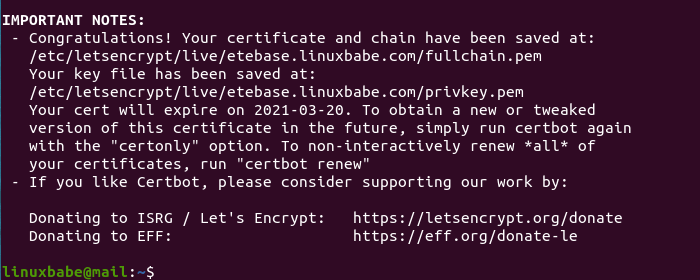
Step 7: Create User Accounts
Create a super admin user.
./manage.py createsuperuser

Then go to etebase.example.com/admin and log into the admin console. Next, you can create individual user accounts to be used for syncing calendars, contacts, tasks, and notes. Notice that you don’t need to create passwords for users in the EteSync admin console, as Etebase uses zero-knowledge proof for authentication.

Now we need to set up clients to use EteSync.
How to Install the Evolution EteSync Module on Ubuntu Desktop
Evolution is the default groupware suite in GNOME desktop environment. You can install it on your Ubuntu desktop with:
sudo apt install evolution
To use EteSync in Evolution, we need to install the EteSync module for Evolution by following the steps below.
Clone the libetebase repository.
sudo apt install git git clone https://github.com/etesync/libetebase.git
Change to the newly-created directory.
cd libetebase/
Install the required packages to build the package from source.
sudo apt install build-essential libssl-dev cargo
Compile the source package.
make
Install the binary.
sudo make install
Then go back to the previous directory.
cd ..
Clone the Evolution-EteSync repository.
git clone https://gitlab.gnome.org/GNOME/evolution-etesync
Change to the newly-created directory.
cd evolution-etesync/
Install the required packages to build the package from source.
sudo apt install cmake intltool evolution-data-server-dev evolution-dev libedata-book1.2-dev libedata-cal2.0-dev libecal2.0-dev libebook1.2-dev
Compile and install the package.
mkdir build cd build cmake -DCMAKE_INSTALL_PREFIX=/usr .. make -j sudo make -j install
Using EteSync in Evolution
Now launch the Evolution app on your Ubuntu desktop. Click the New button in the toolbar and add a new collection account.
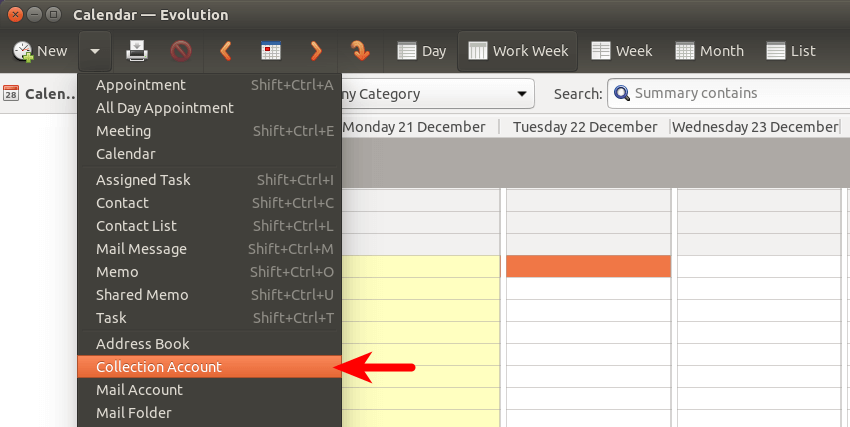
Then enter your EteSync usename and server address. Note that you need to add https:// as the prefix of the server address. Select Look up for an EteSync account and untick all other options. Then click the Look Up button.

It will asks you to enter password to continue. This is actually the time to set the password, so click the Enter password link and set a password.
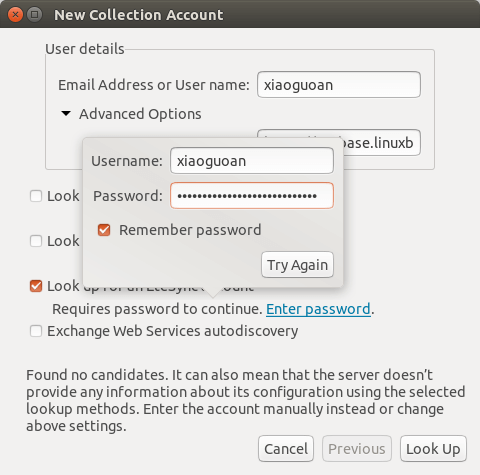
After entering a password, click Try again button and it should find one candidate. Click the Next button to continue.
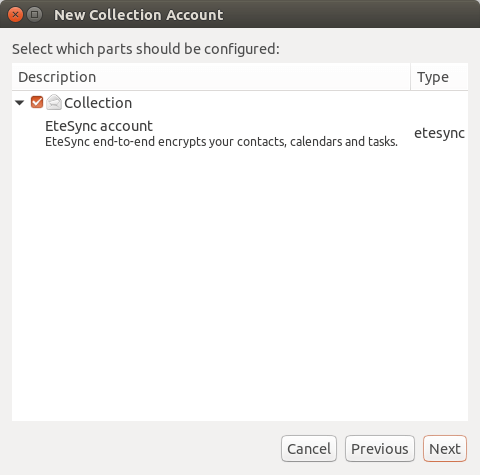
Sync with NextCloud
If you have a self-hosted Nextcloud server and installed the Calendar, Tasks or Contacts app on your Nextcloud server, you can add your Nextcloud DAV server in Evolution, so they can be synced. Simply add another collection account in Evolution, enter your Nextcloud username and CalDAV/CardDAV address, select Look up for a CalDAV/CardDAV server, untick all other options. Then enter your Nextcloud password. The Nextcloud CalDAV/CardDAV address should be https://nextcloud.yourdomain.com/remote.php/dav.
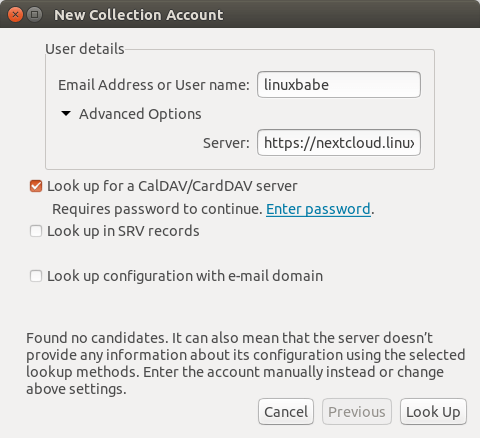
Using the iOS EteSync App
To sync your calendar, contacts, and tasks on iOS, first you need to set up a CalDAV/CardDAV account in iOS. Go to the Settings app -> Calendar -> Accounts -> Add Account -> Other, and add a CalDAV and CardDAV account. CalDAV is used to sync calendars and CardDAV is used to sync contacts on your devices.
If you have a self-hosted Nextcloud server, you can use your Nextcloud CalDAV/CardDAV account. If you don’t have one, simply use a fake account.
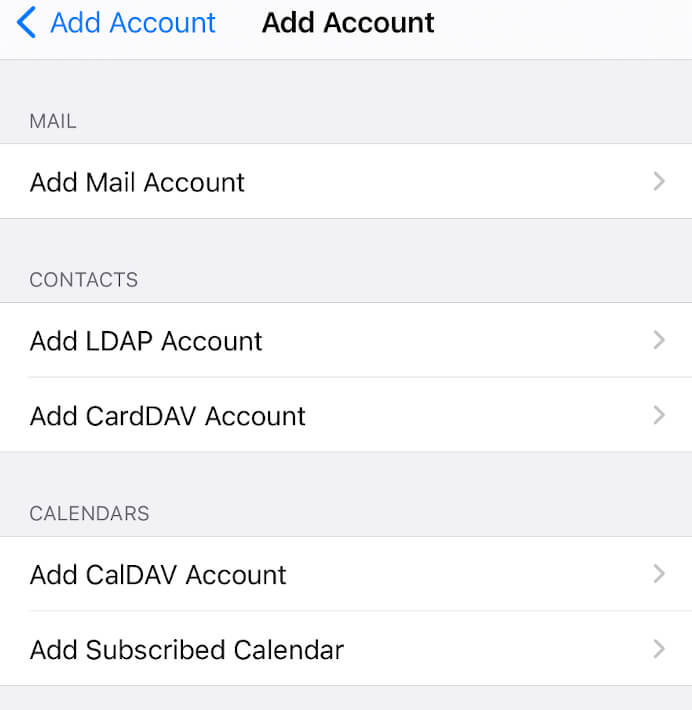
Next, install the EteSync app from the app store. Then add your EteSync account.
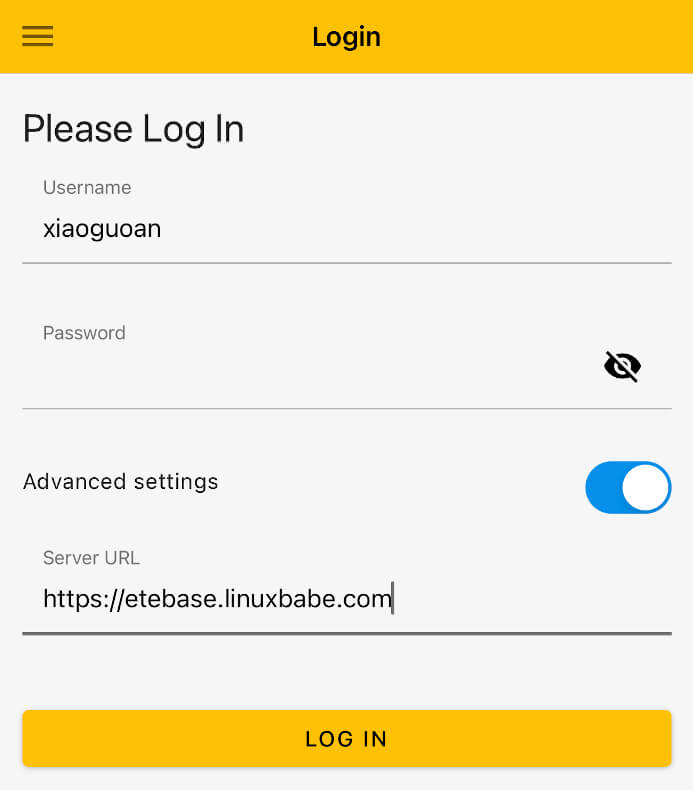
After log into your EteSync account, go to the settings menu in the EteSync app. In the Advanced section, select your CardDAV account for Sync contacts and select your CalDAV account for Sync calendars and reminders.
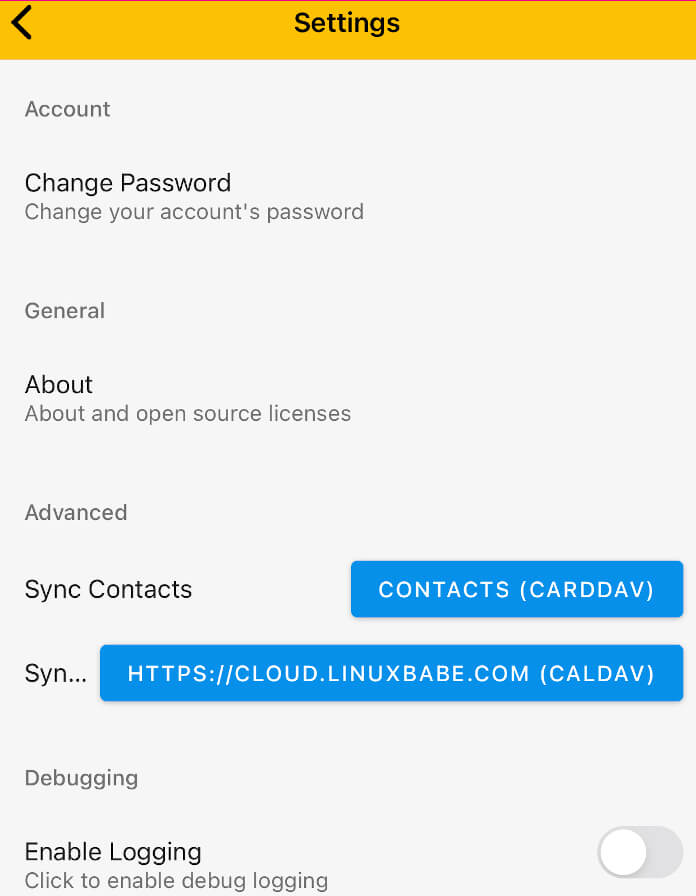
Wrapping Up
I hope this post helped you set up your own EteSync server on Ubuntu. As always, if you found this post useful, then subscribe to our free newsletter for more tips and tricks 🙂



After multiple attempts to install I get the following errors after running
:
Traceback (most recent call last): File "/home/boo/etebase/./manage.py", line 21, in main() File "/home/boo/etebase/./manage.py", line 17, in main execute_from_command_line(sys.argv) File "/home/boo/etebase/.venv/lib/python3.10/site-packages/django/core/management/__init__.py", line 419, in execute_from_command_line utility.execute() File "/home/boo/etebase/.venv/lib/python3.10/site-packages/django/core/management/__init__.py", line 413, in execute self.fetch_command(subcommand).run_from_argv(self.argv) File "/home/boo/etebase/.venv/lib/python3.10/site-packages/django/core/management/base.py", line 354, in run_from_argv self.execute(*args, **cmd_options) File "/home/boo/etebase/.venv/lib/python3.10/site-packages/django/core/management/base.py", line 398, in execute output = self.handle(*args, **options) File "/home/boo/etebase/.venv/lib/python3.10/site-packages/django/core/management/base.py", line 89, in wrapped res = handle_func(*args, **kwargs) File "/home/boo/etebase/.venv/lib/python3.10/site-packages/django/core/management/commands/migrate.py", line 75, in handle self.check(databases=[database]) File "/home/boo/etebase/.venv/lib/python3.10/site-packages/django/core/management/base.py", line 419, in check all_issues = checks.run_checks( File "/home/boo/etebase/.venv/lib/python3.10/site-packages/django/core/checks/registry.py", line 76, in run_checks new_errors = check(app_configs=app_configs, databases=databases) File "/home/boo/etebase/.venv/lib/python3.10/site-packages/django/core/checks/database.py", line 13, in check_database_backends issues.extend(conn.validation.check(**kwargs)) File "/home/boo/etebase/.venv/lib/python3.10/site-packages/django/db/backends/mysql/validation.py", line 9, in check issues.extend(self._check_sql_mode(**kwargs)) File "/home/boo/etebase/.venv/lib/python3.10/site-packages/django/db/backends/mysql/validation.py", line 13, in _check_sql_mode if not (self.connection.sql_mode & {'STRICT_TRANS_TABLES', 'STRICT_ALL_TABLES'}): File "/home/boo/etebase/.venv/lib/python3.10/site-packages/django/utils/functional.py", line 48, in __get__ res = instance.__dict__[self.name] = self.func(instance) File "/home/boo/etebase/.venv/lib/python3.10/site-packages/django/db/backends/mysql/base.py", line 405, in sql_mode sql_mode = self.mysql_server_data['sql_mode'] File "/home/boo/etebase/.venv/lib/python3.10/site-packages/django/utils/functional.py", line 48, in __get__ res = instance.__dict__[self.name] = self.func(instance) File "/home/boo/etebase/.venv/lib/python3.10/site-packages/django/db/backends/mysql/base.py", line 366, in mysql_server_data with self.temporary_connection() as cursor: File "/usr/lib/python3.10/contextlib.py", line 135, in __enter__ return next(self.gen) File "/home/boo/etebase/.venv/lib/python3.10/site-packages/django/db/backends/base/base.py", line 603, in temporary_connection with self.cursor() as cursor: File "/home/boo/etebase/.venv/lib/python3.10/site-packages/django/utils/asyncio.py", line 33, in inner return func(*args, **kwargs) File "/home/boo/etebase/.venv/lib/python3.10/site-packages/django/db/backends/base/base.py", line 259, in cursor return self._cursor() File "/home/boo/etebase/.venv/lib/python3.10/site-packages/django/db/backends/base/base.py", line 235, in _cursor self.ensure_connection() File "/home/boo/etebase/.venv/lib/python3.10/site-packages/django/utils/asyncio.py", line 33, in inner return func(*args, **kwargs) File "/home/boo/etebase/.venv/lib/python3.10/site-packages/django/db/backends/base/base.py", line 219, in ensure_connection self.connect() File "/home/boo/etebase/.venv/lib/python3.10/site-packages/django/utils/asyncio.py", line 33, in inner return func(*args, **kwargs) File "/home/boo/etebase/.venv/lib/python3.10/site-packages/django/db/backends/base/base.py", line 199, in connect conn_params = self.get_connection_params() File "/home/boo/etebase/.venv/lib/python3.10/site-packages/django/db/backends/mysql/base.py", line 217, in get_connection_params options = settings_dict['OPTIONS'].copy() AttributeError: 'SectionProxy' object has no attribute 'copy'What should I do to fix this?
I have the same, did you find a solution?
I was able to find a solution for this – https://github.com/etesync/server/issues/161